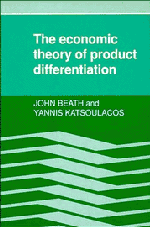Book contents
- Frontmatter
- Contents
- Preface
- 1 Introduction
- 2 Spatial models of imperfect competition
- 3 Symmetric preferences, the Chamberlinian paradigm
- 4 Product diversity and product selection: market equilibria and social optima
- 5 Product quality and market structure
- 6 Vertical product differentiation
- 7 Product differentiation and market imperfection: limit theorems
- 8 Product differentiation and the entry process
- 9 The gains from trade under product differentiation
- Notes
- Bibliography
- Indexes
2 - Spatial models of imperfect competition
Published online by Cambridge University Press: 03 May 2010
- Frontmatter
- Contents
- Preface
- 1 Introduction
- 2 Spatial models of imperfect competition
- 3 Symmetric preferences, the Chamberlinian paradigm
- 4 Product diversity and product selection: market equilibria and social optima
- 5 Product quality and market structure
- 6 Vertical product differentiation
- 7 Product differentiation and market imperfection: limit theorems
- 8 Product differentiation and the entry process
- 9 The gains from trade under product differentiation
- Notes
- Bibliography
- Indexes
Summary
Introduction
The task that we have set ourselves in this chapter is to examine the literature on product differentiation and imperfect competition that developed from Hotelling's seminal 1929 article entitled ‘Stability in Competition’. The central conceptual idea is that consumers have heterogeneous tastes in the sense that each differs in what he or she considers to be the ideal brand from among the set of available products. Furthermore it is also assumed that these preferences are asymmetric. What this means is that if a consumer's ideal brand is i then the consumer prefers brands that are ‘near’ to i in terms of their specification (or combination of characteristics) more than those that are ‘far’ from it. This is in sharp contrast to the Chamberlinian model which we shall look at in the next chapter. In it consumers have symmetric preferences over the different brands and, in consequence, a ‘representative consumer’ is used to represent the whole consumer population.
In order to make the notion of asymmetric preferences clearer, it is helpful to think of brands as being represented by points in a multidimensional space. Asymmetry then just means that any particular consumer, identified and located by virtue of what he considers to be the ideal set of characteristics at some point in this space, will consider ‘neighbouring’ brands close to his ‘location’ to be very close substitutes. However, the further away that a brand is from this ideal point, the less close is it a substitute.
- Type
- Chapter
- Information
- The Economic Theory of Product Differentiation , pp. 11 - 41Publisher: Cambridge University PressPrint publication year: 1991



